behavior / coup d'etats - booknotes
Summary:
This document provides a comprehensive analysis of coup d’états, including their definition, conditions for occurrence, strategic planning, execution tactics, and statistical data on historical coups. It offers insights into governmental structures, intervention forces, infiltration strategies, and the economic implications of repression.
Outline
- 1. What Is the Coup d’État?
- 2. When Is a Coup d’État Possible?
- 3. The Strategy of the Coup d’État
- 3.1. Formal Structures and Real Chains of Command
- 3.2. Potential Forces of Intervention
- 3.3. Infiltration Strategies
- 4. The Planning of the Coup d’État
- 4.1. Influencing Government Policies
- 4.2. Communication Facilities and Their Roles
- 5. The Execution of the Coup d’État
- 5.1. Mechanics of Intervention
- 5.2. Timing and Coordination
- A. The Economics of Repression
- B. Tactical Aspects of the Coup d’État
- C. Statistics
Glossary
| Term | Definition |
|---|---|
| 1. **Coup d'État** | A sudden and illegal seizure of government power, typically executed by a small group, often including elements of the military. |
| 2. **Intervention Forces** | Military or paramilitary units that are mobilized to either support or suppress a coup attempt. |
| 3. **Infiltration Strategy** | A tactical approach to insert loyalists into key positions within the government or military to facilitate a coup. |
| 4. **Operational Sequence** | The planned sequence of actions to be executed during a coup, including timing and coordination. |
| 5. **Repression** | Actions taken by a government to suppress dissent and maintain control, often involving the use of force or intimidation. |
| 6. **Real Chains of Command** | The actual control dynamics within a government or military unit, which may differ from the formal hierarchy. |
| 7. **Communication Facilities** | Systems used for transmitting information, crucial for coordinating coup activities and managing misinformation. |
| 8. **Ethnic Minorities** | Groups within a state that may have distinct cultural or social identities, which can influence political dynamics during a coup. |
| 9. **Success Rate of Coups** | The statistical analysis of how often coup attempts achieve their goals compared to those that fail. |
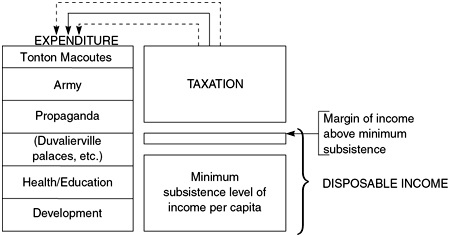
Summary:
This document analyzes the challenges faced by newly established governments in economically backward countries, exploring the balance between economic development and political stability, highlighting methods of propaganda and repression used to maintain control, and examining historical examples of regimes that successfully navigated these dynamics.
Outline
- 1. Introduction
- 1.1 The Importance of Economic Development
- 1.2 The Conflict Between Development and Stability
- 2. Economic Development and Investment
- 2.1 Human and Physical Capital
- 2.2 Limits on Taxation
- 2.3 Political and Economic Survival Limits
- 3. Balancing Development and Repression
- 3.1 Instruments of Control: Propaganda and Repression
- 3.1.1 Efficiency of Repression and Spending
- 3.2 Historical Case Studies
- 3.2.1 François Duvalier in Haiti
- 3.2.2 Kwame Nkrumah in Ghana
- 3.3 The Middle Way: Successful Combinations
- 4. Conclusion
- 4.1 The Interchangeability of Repression, Propaganda, and Economic Growth
- 4.2 Future Considerations for Regime Survival
Glossary
| Term | Definition |
|---|---|
| 1. Political Survival Limit | The threshold of public dissatisfaction that may lead to government overthrow if exceeded. |
| 2. Economic Survival Limit | The minimum annual income necessary for individuals to meet basic bodily needs. |
| 3. Propaganda | Activities aimed at distracting the populace from current hardships while justifying them and promoting future happiness under the current leadership. |
| 4. Repression | Measures taken by the government to suppress dissent and control public opinion through surveillance, intimidation, and censorship. |
| 5. Elite | A select group of individuals with significant power or influence, often associated with governance and economic opportunities in society. |
| 6. Taxation | The process of collecting financial contributions from individuals or businesses to fund government projects and services. |
| 7. Foreign Aid | Financial or material assistance provided by one country to another, often to support economic development or humanitarian needs. |
| 8. Tonton Macoute | A militia formed in Haiti under Duvalier, known for violence and repression against the opposition. |
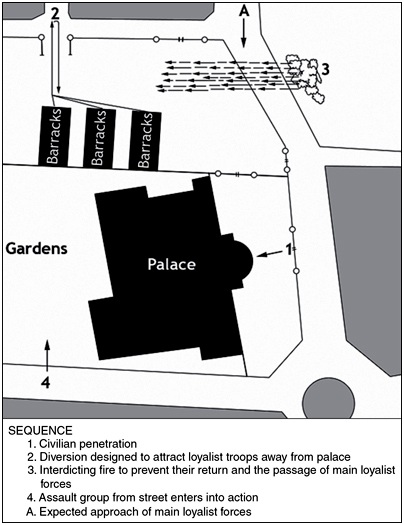
Summary:
This document outlines the tactical considerations and operational strategies for executing a coup d’état, focusing on the formation of active teams and the deployment of blocking forces to minimize bloodshed and ensure post-coup security.
Outline
- 1. Introduction to Tactical Aspects
- 1.1 Importance of Minimizing Bloodshed
- 1.1.1 Overview of Coup Components
- 2. Formation of the Active Teams
- 2.1 Types of Infiltration
- 2.1.1 Diffuse Infiltration
- 2.1.2 Concentrated Infiltration
- 2.2 Structure and Function of Teams
- 2.2.1 A-Teams
- 2.2.1.1 Civilian Penetration Group
- 2.2.1.2 Diversion Group
- 2.2.1.3 Covering Fire Group
- 2.2.1.4 Assault Group
- 2.2.2 B-and C-Teams
- 3. Deployment of the Blocking Forces
- 3.1 Necessity of Blocking Forces
- 3.1.1 Counteracting Loyalist Forces
- 3.1.2 Structure of the Blocking Position
- 3.2 Operational Leadership and Defensive Measures
- 3.2.1 Role of Intelligence
- 3.2.2 Use of Natural Barriers and Roadblocks
Glossary
| Term | Definition |
|---|---|
| - **Coup d’État** | A sudden overthrow of a government, typically involving the illegal seizure of power by a small group. |
| - **Active Teams** | Tactical units formed to conduct operations in seizing objectives during a coup, divided into groups with specific functions. |
| - **Blocking Forces** | Units deployed to prevent intervention from loyalist forces during a coup, aiming to control passages into key areas while causing minimal damage. |
| - **A-Teams** | Specialized groups tasked with taking major defended objectives, utilizing various operational elements. |
| - **B-Teams** | Units responsible for arresting key political figures during the coup. |
| - **C-Teams** | Small tactical groups focused on sabotaging infrastructure and facilities deemed threatening. |
| - **Subversion** | The act of undermining the power and authority of an established system, particularly in military or governmental contexts. |
| - **Intelligence** | Information gathered concerning the location and motives of loyalist forces in a coup scenario, essential for strategic planning. |
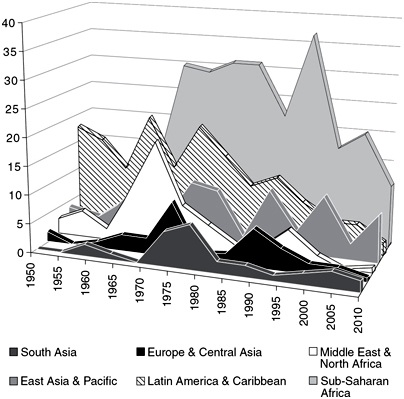
Summary:
This document presents a comprehensive analysis of coups d'état and their correlation with economic development between 1945 and 2010, providing data on the frequency, outcomes, and efficiency of these events as well as a detailed account of individual cases across various regions.
Outline
- 1. Introduction
- 1.1 Purpose of the document
- 1.2 Scope and timeframe
- 2. Statistical Overview
- 2.1 Economic development and coups
- 2.1.1 Data from World Bank and IMF
- 2.2 Coup frequency analysis
- 2.2.1 Regional distribution
- 2.2.2 Time distribution
- 3. Detailed Case Studies
- 3.1 Sub-Saharan Africa
- 3.1.1 Successful coups
- 3.1.2 Failed coups
- 3.2 East Asia and Pacific
- 3.2.1 Successful coups
- 3.2.2 Failed coups
- 3.3 Europe and Central Asia
- 3.3.1 Successful coups
- 3.3.2 Failed coups
- 3.4 Latin America and Caribbean
- 3.4.1 Successful coups
- 3.4.2 Failed coups
- 3.5 Middle East and North Africa
- 3.5.1 Successful coups
- 3.5.2 Failed coups
- 3.6 South Asia
- 3.6.1 Successful coups
- 3.6.2 Failed coups
- 4. Conclusion
- 4.1 Implications of findings
- 4.2 Future research recommendations
Glossary
| Term | Definition |
|---|---|
| - **Coup d'état** | A sudden and illegal seizure of government power, typically executed by a small group of individuals, often the military. |
| - **Per capita GDP** | The gross domestic product of a country divided by its population, used as a measure of the economic output per individual. |
| - **Failed coup** | An attempt to overthrow a government that does not succeed. |
| - **Successful coup** | An attempt to overthrow a government that results in the establishment of a new regime. |
| - **Political faction** | A group within a larger political body that has distinct beliefs or agendas differing from the larger group. |
| - **Army faction** | A faction that comprises members of the military who engage in political activities, including coups. |
| - **Economic development** | The process of improving the economic well-being and quality of life for a community by creating and retaining jobs and supporting or growing incomes. |
Summary:
This document explores the concept of coup d'état, detailing its definition, historical context, mechanisms of implementation, and various forms, while analyzing the relationship between modern state structures and the feasibility of coups.
Outline
- 1. Introduction to Coup d'État
- 1.1 Historical Context
- 1.2 Modern State and Coup Feasibility
- 2. Mechanisms and Structure of a Coup
- 2.1 Insider vs. Outsider Coups
- 2.2 State Bureaucracy's Role
- 3. Forms of Coup d'État
- 3.1 Revolutions
- 3.2 Civil Wars
- 3.3 Pronunciamiento
- 3.4 Putsch
- 3.5 Liberation
- 3.6 National Liberation and Insurgencies
- 4. Definition and Characteristics of Coup d'État
- 4.1 Key Distinctions from Other Forms
- 4.2 Political Neutrality and Configurations
Glossary
| Term | Definition |
|---|---|
| Coup d'état | The illegal seizure of power from a government, typically involving a small but critical segment of the state apparatus to displace the current leadership without widespread public support or mass violence. |
| Palace Revolution | A coup that occurs from within the political hierarchy, typically involving manipulation of the existing ruler rather than a complete change of government. |
| Pronunciamiento | A military revolt specifically associated with Spanish and Latin American contexts, characterized by a formal declaration of intent to rebel by army leaders. |
| Putsch | A sudden and unlawful attempt to overthrow a government, often carried out by a faction within the military, particularly in wartime situations. |
| Revolution | A significant and often violent change in political and social structures, typically involving mass participation to achieve broader societal fundamentally changes. |
| Civil War | An internal conflict characterized by organized groups within a country fighting against each other for control or political power. |
| National Liberation | A movement aimed at ending foreign control within a state, typically resulting in the overthrow of existing governments through various means. |
Summary:
The document explores the necessary conditions for a coup d'État, highlighting the socioeconomic indicators, historical examples, and the dynamics of political legitimacy and participation that influence the success and feasibility of coups throughout history.
Outline
- 1. Introduction to Coups d'État
- 1.1 Historical Context and Examples
- 1.1.1 Lenin's Call to Action
- 1.1.2 The Bolsheviks' Immediate Seizure of Power
- 2. The Expansion of Independent States Post-WWII
- 2.1 Target States for Coups
- 2.1.1 Developed vs. Underdeveloped Countries
- 2.1.2 Examples of Political Stability and Instability
- 3. Factors Influencing Coup Feasibility
- 3.1 Conditions Leading to Potential Coups
- 3.1.1 Economic and Political Instability
- 3.1.2 Historical Precedents in France and Italy
- 3.2 The Role of the Population's Engagement
- 3.2.1 Apathy vs. Active Participation
- 3.2.2 The Impact of Social Dynamics and Dialogue
- 4. Case Studies of Political Systems
- 4.1 The Communist Party in China
- 4.1.1 Economic Corruption and Political Power
- 4.2 The Breakdown of Political Life in France (1958)
- 4.2.1 The Rise of Charles de Gaulle
- 5. Preconditions for Successful Coups
- 5.1 Indicators of Coups in Various Countries
- 5.1.1 Economic Backwardness and Social Detachment
- 5.1.2 Political Passivity and Acceptance of Authority
Glossary
| Term | Definition |
|---|---|
| - Coup d'État | A sudden, illegal ousting of a government or leader by a small group, often involving military forces. |
| - Legitimacy | The recognized right of a government to rule, often based on legal or political foundations accepted by the population. |
| - Political Apathy | A lack of interest or concern among the public regarding political processes or government affairs. |
| - Bureaucracy | An administrative system governing any large institution, characterized by hierarchical organization and regulated procedures. |
| - Economic Backwardness | A condition in which a country's economic development is significantly lower than that of others, often marked by poverty and low standards of living. |
| - Dialogue | The ongoing communication and interaction between rulers and citizens regarding governance and policies. |
| - Ethnic and Historical Background | The cultural, social, and historical contexts affecting a nation’s political landscape and identity. |
| - Urban Poor | Individuals living in cities who experience economic hardship and lack access to resources and opportunities. |
| - Social and Economic Characteristics | Traits that define a society's structure and prioritize its members' economic behavior and interactions. |
| - Nationalism | A political ideology that emphasizes the interests and culture of a particular nation, often leading to feelings of pride or superiority. |
Summary:
This document outlines the strategic considerations and operational imperatives involved in executing a coup d'État, emphasizing the need for speed, the neutralization of state defenses, and the management of political forces to establish control and maintain authority amidst potential opposition.
Outline
- 1. Introduction to Coup Strategy
- 1.1 Importance of Speed and Neutralization
- 1.2 Distinction Between Coup and Revolution
- 2. Neutralizing State Defense
- 2.1 Role of Armed Forces and Police
- 2.2 Importance of Political Forces
- 3. Mechanisms of Control
- 3.1 Recruitment of Personnel
- 3.2 Use of Party Militias
- 4. Historical Examples and Case Studies
- 4.1 Russia 1917
- 4.2 Weimar Germany
- 5. Organizational Challenges in Modern States
- 5.1 Fragmentation of Intelligence Agencies
- 5.2 Overview of U.S. Intelligence Organizations
Glossary
| Term | Definition |
|---|---|
| 1. Coup d'État | A sudden and illegal seizure of government power, typically led by a small group or military faction. |
| 2. Neutralization | The process of diminishing or eliminating opposition or resistance from political or military forces to ensure stability. |
| 3. Political Forces | Various groups and interests within society, such as political parties and ethnic constituencies, that influence or oppose government actions. |
| 4. Armed Forces | A country's military forces, including army, navy, and air force, responsible for protecting the state and enforcing order. |
| 5. Security Services | Agencies tasked with maintaining internal security, including the police and intelligence organizations. |
| 6. Revolutionary Attrition | The gradual weakening of an opposing power through prolonged conflict and strategic engagement. |
| 7. Political Coloration | The perception of a political agenda or affiliation that emerges during a coup, which may provoke opposition. |
| 8. Party Militia | Armed groups formed by political parties that often act as enforcers or protectors of party interests during times of instability. |
| 9. Transition Phase | The critical period immediately following a coup, where new authority is established and existing power structures are neutralized. |
| 10. Intelligence Community | The collective agencies and organizations responsible for gathering, analyzing, and acting on national security information. |
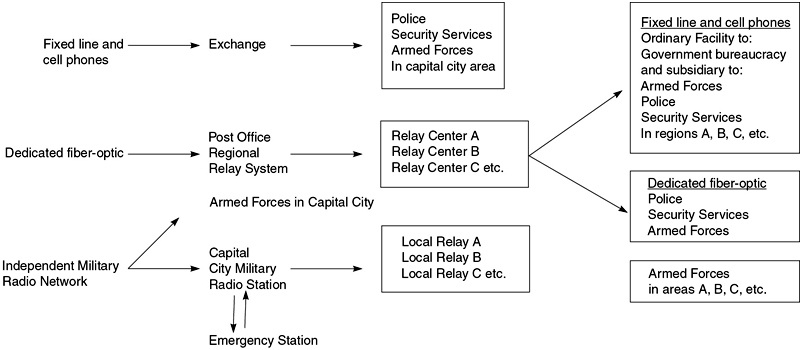
Summary:
This document analyzes the failed coup d'état in Algeria in April 1961, highlighting the neglect of political forces by military leaders and detailing the strategies necessary for effectively neutralizing political intervention when attempting to seize power.
Outline
- 1. Introduction to the Coup d'État in Algeria
- 1.1 Overview of the coup's execution on April 23, 1961
- 1.2 Key military figures involved
- 1.3 Context of de Gaulle's government negotiations
- 2. Factors Leading to Coup Failure
- 2.1 Neglect of Political Forces
- 2.2 Support from Societal Organizations
- 2.3 de Gaulle’s Appeal to the Population
- 3. Strategies for Neutralizing Political Forces
- 3.1 Importance of Infrastructure in Political Action
- 3.2 Seizure of Communication and Transport Facilities
- 3.3 Identification and Isolation of Political Leaders
- 3.3.1 Managing Government Personalities
- 3.3.2 Analyzing Government Structures
- 4. Conclusion
- 4.1 Lessons Learned from the Coup
- 4.2 Implications for Future Coup Planning
Glossary
| Term | Definition |
|---|---|
| 1. **Coup d'État** | A sudden, illegal seizure of government power, typically executed by a small group. |
| 2. **Pieds Noirs** | French citizens of European ancestry, particularly those who lived in Algeria during French rule. |
| 3. **Attentiste** | A term describing individuals or groups adopting a wait-and-see approach, often refraining from taking sides amid political turmoil. |
| 4. **Political Forces** | Groups within society that have the power to influence government policies and decisions, including pressure groups and political parties. |
| 5. **Neutralization** | The act of rendering a force ineffective or harmless, particularly in the context of political opposition during a coup. |
| 6. **Baton** | The symbolic or actual means of authority or control, often associated with military power. |
| 7. **Infrastructure** | The fundamental facilities and systems serving a country, including communication, transport, and organizational structures crucial for political action. |
| 8. **Strongman** | An authoritarian leader who wields power without formal political legitimacy, often ruling through coercive means. |
| 9. **General Strike** | A coordinated work stoppage by a large number of employees across multiple sectors, intended to assert political demands. |
| 10. **Political Leadership** | Key individuals in a government or organization that hold significant power and influence, essential in maintaining or opposing regimes. |
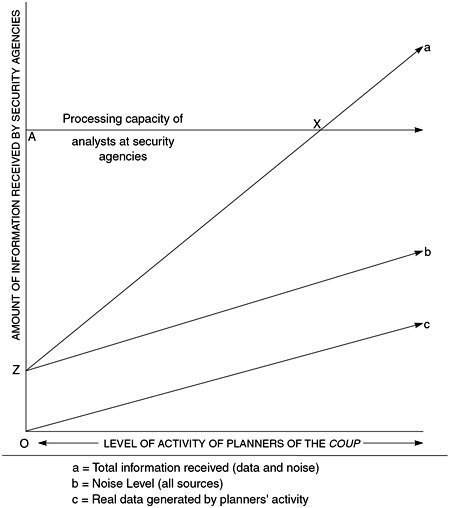
Summary:
The document provides a detailed analysis of the execution phase of a coup d'état, emphasizing the importance of rapid, coordinated action while outlining strategies for neutralizing loyalist forces and maintaining operational security.
Outline
- 1. The Nature of a Coup d'État
- 1.1 Similarities to Military Operations
- 1.2 Requirements for Success
- 2. Pre-Coup Planning
- 2.1 Target Selection and Neutralization
- 2.2 Importance of Security Procedures
- 3. Execution Phase
- 3.1 Timing and Sequence of Operations
- 3.2 Managing Loyalist Forces
- 3.2.1 Creating Blocking Positions
- 3.2.2 Psychological and Tactical Advantages
- 4. Post-Coup Considerations
- 4.1 Managing Arrests and Political Leadership
- 4.2 Aftermath and Consolidation of Power
Glossary
| Term | Definition |
|---|---|
| 1. Coup d'État | A sudden and illegal seizure of government power, typically executed by a small group, often involving the military. |
| 2. Infiltration | The process of secretly gaining access to the personnel or operations of an organization, in this context, the military and security forces. |
| 3. Neutralization | Actions taken to render opposing forces incapable of intervening or responding effectively against a particular plan or action. |
| 4. Blocking Position | A defensive setup used to impede the movement of loyalist forces during a coup. |
| 5. Bandwagon Effect | A phenomenon where individuals align with a group in a decision, often as the perceived support for that group grows. |
| 6. Security Agencies | Organizations tasked with national security, including espionage and counterintelligence operations. |
| 7. Tactical Flexibility | The capability to adjust tactics rapidly during operations based on evolving circumstances. |
| 8. Lead Time | The amount of time required for a team to reach its target once given the go-signal to execute an operation. |
Summary:
This document analyzes the political landscape and military structures in the Middle East and sub-Saharan Africa, focusing on postcolonial transitions, key military figures, political party dynamics, and the interaction between armed forces and civil governance, particularly during coups and unrest.
Outline
- 1. Introduction
- 1.1 Overview of Political Dynamics
- 1.2 Importance of Military Influence
- 2. Regional Context
- 2.1 Middle East
- 2.1.1 Key Political Figures
- 2.1.2 Political Parties
- 2.2 Sub-Saharan Africa
- 2.2.1 Postcolonial Challenges
- 2.2.2 Emergent Democracies
- 3. Armed Forces and Governance
- 3.1 Role in Coups
- 3.1.1 Recruitment and Loyalty
- 3.1.2 Response during Political Unrest
- 3.2 Internal Security Forces
- 3.2.1 Communication and Structure
- 3.2.2 Civilian Control and Effectiveness
Glossary
| Term | Definition |
|---|---|
| 1. **Alawites** | A sect within Shia Islam predominantly based in Syria, often associated with the ruling family and military leadership. |
| 2. **Ba‘ath Party** | A political party advocating for Arab unity and socialism, prominent in countries like Syria and Iraq. |
| 3. **Coup** | A sudden overthrow of a government, typically conducted by a small group that utilizes the military. |
| 4. **Emergent Democracies** | New democratically elected governments that arise after periods of authoritarian rule or colonialism. |
| 5. **Postcolonial Misgovernment** | Poor governance and political instability occurring in nations following the end of colonial rule. |
| 6. **Pronunciamiento** | A formal declaration or statement made by military leaders, often related to political or coup actions. |
| 7. **Secularism** | The principle of separating religion from political and governmental affairs, significant in discussions about governance in Muslim-majority countries. |
| 8. **Slogans and Early Information** | Tools used by military groups to rally support or communicate their agenda during coups or political movements. |
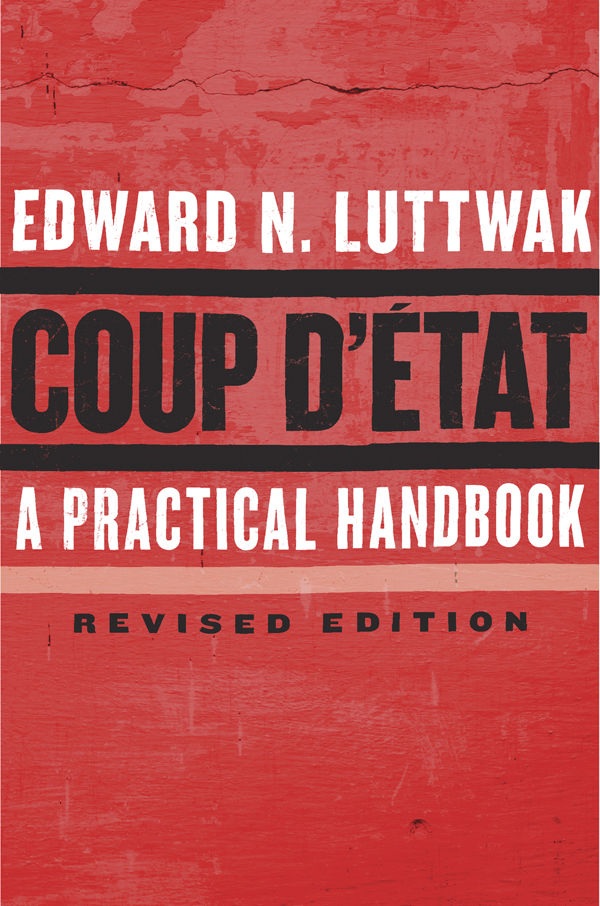
Summary:
This handbook by Edward N. Luttwak explores the theory and practice of coups d’état, detailing their strategies, planning, and execution. It examines the political dynamics behind coups, the role of corruption, and modern anti-coup measures. The updated 2016 edition reflects on changes in coup dynamics since the original publication in 1968 and highlights the enduring essence of coups as a distinct form of political action requiring a blend of military force and tactical persuasion.
Outline
- 1. Prefaces
- 1.1 Acknowledgment
- 1.2 Preface to the 2016 Edition
- 1.3 Preface to the First Edition
- 1.4 Foreword by Walter Laqueur (1978)
- 2. Introduction to Coups d'État
- 2.1 Definition of Coup d'État
- 2.2 Historical Context
- 3. Dynamics of Coup d'État
- 3.1 Conditions for a Successful Coup
- 3.2 Corruption as a Motivator
- 3.3 Anti-Coup Measures
- 4. Planning and Execution
- 4.1 Strategy Development
- 4.2 Tactical Considerations
- 4.3 Communication and Coordination
- 5. Aftermath and Future of Coups
- 5.1 Economic Consequences
- 5.2 Statistical Analysis of Coups
- 5.3 Trends in Coup Activity (1950-2010)
Glossary
| Term | Definition |
|---|---|
| - Coup d’État | A sudden, illegal seizure of government power, often executed by a small group, typically involving elements of the military or political establishment. |
| - Corruption | The abuse of entrusted power for private gain, which can serve as a motivator for coup plotters seeking personal enrichment. |
| - Anti-coup Measures | Strategies and practices implemented by governments to prevent or mitigate the risk of coups, including the establishment of distinct security forces and internal espionage networks. |
| - Espionage | The practice of spying or using spies to gather confidential information, particularly focused on monitoring military and security forces for signs of conspiratorial activity. |
| - Regime | The governing authority of a state, which may be democratic or authoritarian, that possesses the power to enact and enforce laws. |
| - Political Survival | The ability of a government or leader to maintain power and stability, often influenced by public support, economic conditions, and internal security. |
| - Telecommunications | Systems and technologies used for communication, particularly vital for the coordination of government actions and responses during a coup. |